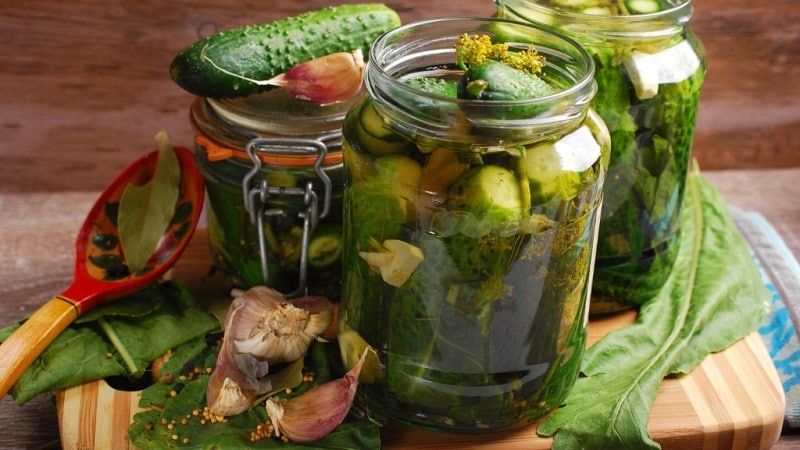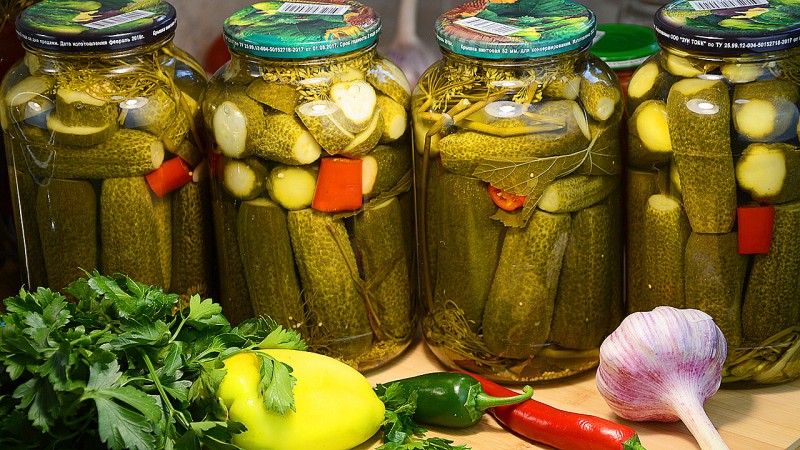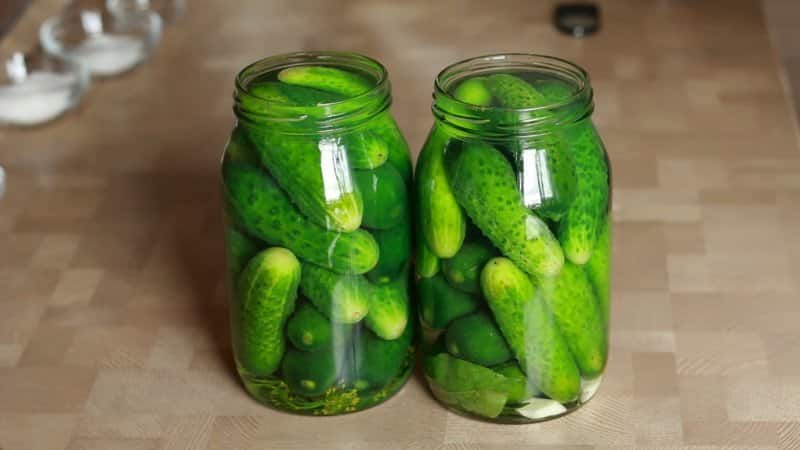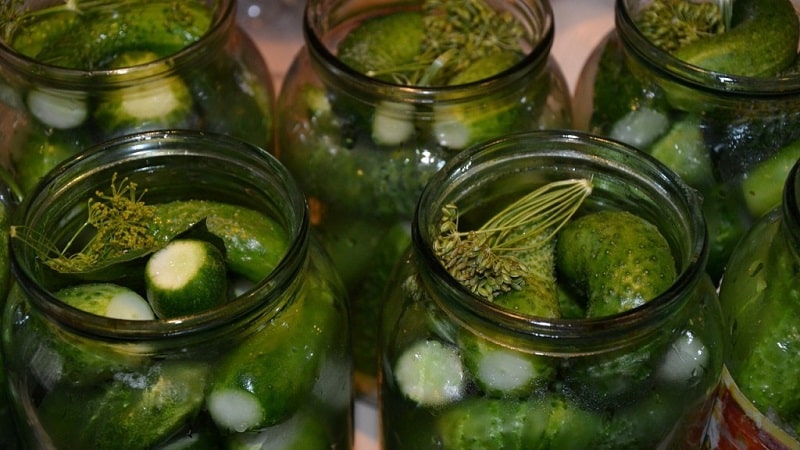Pickling cucumbers in jars for the winter to prevent them from exploding: recipes, rules for preparing vegetables and storing preparations
Even housewives with many years of experience in canning vegetables at home sometimes have twists that explode. How to protect yourself from wasted work and make sure that not a single bank goes missing? Let's learn how to make delicious cucumbers quickly and correctly.
Why do jars of pickles explode?
The only one cause – presence of microbes under the lid. They cause the fermentation process with the release of gases. First, the brine becomes cloudy, then the lid begins to swell.
If the jar is in a closet or on the mezzanine, where the owner rarely looks, an explosion will eventually occur. The lid is torn off the neck of the jar: there are too many gases, and they find a way out at the weakest point.
How to salt so that jars don't explode
Microorganisms that cause the fermentation process cannot withstand high temperatures, therefore, when preparing canned food for the winter, housewives thoroughly wash the containers and lids and then sterilize them. Vegetables are also subjected to pre-treatment, including heat.

Features of preparing cucumbers
The fruits are soaked in cold, clean water for 2-6 hours. If the cucumbers were taken from your garden and were not lying anywhere, 2 hours is enough. Fruits purchased at the market are placed in water for 6 hours - in this case it is impossible to know exactly how much time has passed since they were collected.
During soaking, even fresh cucumbers absorb moisture.But such preparation is needed not only so that they acquire elasticity, but also to fill possible internal cavities (voids) with moisture.
On a note. For pickling and pickles, prickly varieties of cucumbers are chosen. Many housewives soak them immediately, without pre-treatment. Ideally, before immersing in water, the fruits are thoroughly washed using a soft brush to remove dirt and dust in the spaces between the pimples, and then the ends are trimmed on both sides.
Also, when cutting off the edges, it becomes possible to see whether the cucumber is affected from the inside by some disease or pest.
Rules for the sterilization and twisting process
To ensure that bacteria do not have a chance to survive inside sealed jars, properly sterilize containers and lids. There are many methods of disinfection, but whichever one you choose, the jars are first washed with baking soda or a cleaning agent. Housewives have adapted to perform this procedure using:
- microwave ovens;
- multicooker;
- steamer;
- ovens.
All these methods of sterilization are good in their own way, but the simplest and most reliable is steamed, which is what our grandmothers did.
A small saucepan filled 1/3 with water is placed on the fire and covered with a special limiter - a device with a round hole, the diameter of which is designed to fit the standard neck of any jar. Sterilize with steam by placing the containers upside down.
Sterilization time depends on the container volume:
- half-liter jars are kept over steam for 5-10 minutes;
- liter ones are sterilized for 15-20 minutes;
- three-liter - 25-30 minutes.
After removing the sterilized jar from the stopper, do not place it upside down on the towel. Some housewives believe that this will protect the dishes from bacteria, but this is a mistaken opinion.
Neither containers nor lids should come into contact with anything after sterilization. This is especially true for lids. It doesn't take long to sterilize them, so start 5 minutes before twisting.
When adding spices and cucumbers, some of the bacteria will get inside the jar and on the rim of the neck. They will die during the canning process if everything is done correctly:
- Pour boiling water in a thin stream to the very top into a jar with cucumbers and spices and cover with a lid.
- Leave for 10 minutes, then drain the water into a saucepan and boil for 3 minutes.
- Pour vinegar into the jar and fill it to capacity with marinade.
- Remove the lid from the pan of boiling water and immediately carefully place it on the neck of the jar (excess marinade will spill out from under the lid).
- Screw on the screw lid using a kitchen towel; roll up the simple lid using a special machine.
Place the sealed jars upside down on a kitchen towel and cover them to cool gradually. Turn the seams over to make sure they are sealed.
Recipes for pickling cucumbers that won't explode

The method of preparing cucumbers by pickling is a win-win in terms of storage. During the fermentation process, lactic acid bacteria are produced. They produce lactic acid, which has disinfectant properties and therefore kills harmful bacteria.
Cucumbers are salted cold and hot. In the first case, the jars will have to be stored in a cellar or refrigerator under a plastic cover. When pickling using the hot method, jars of cucumbers are closed in the same way as when pickling, and they are perfectly stored in apartment conditions.
Use our recipes for pickling cucumbers in jars for the winter so that they do not explode or become cloudy.
Cold salting
This method originally used in Rus'. In those days, cucumbers were pickled in oak tubs. This method has been preserved to this day in villages whose residents have spacious cellars. City housewives adopted the method of pickling in 3-liter jars. To make cucumbers in glass containers crispy, horseradish, oak and cherry leaves are added to the brine.
Hot salting
Pickled cucumbers the same way - in 3-liter jars and with the same set of spices. The hot method of pickling differs from the cold method only in that at the end of the active fermentation process, the brine is poured from the jars into a pan, boiled and, after pouring back, the containers are rolled up with tin lids.
Regardless of which method the greens were salted, hot or cold, the pickling method itself is also called barrel, because if all the rules are followed, cucumbers are obtained exactly like from a barrel.
Cucumbers in jars “Like barrels”
This recipe for pickled cucumbers is extremely simple: in addition to the fruits, you only need salt, water, garlic, dill umbrellas, horseradish, oak and cherry leaves:
- Place a horseradish leaf, an umbrella of dill and a few cloves of garlic at the bottom of the jar.
- Place fresh, prepared cucumbers as tightly as possible, as many as will fit in the jar.
- During the laying process, add 2-3 leaves of cherry and oak.
- Place another leaf of horseradish and an umbrella of dill on top.
- Dissolve 100 g of coarse salt in a mug of clean drinking water and pour into a jar with cucumbers.
- Fill to the very top with plain drinking water, close with a plastic lid and turn the jar in your hands several times so that the fresh water mixes well with the salt water.
- Remove the lid and, turning it upside down, simply place it on the neck of the jar.
- Place the jar of cucumbers in a bowl and leave at room temperature for 72 hours.
During the fermentation process, a film forms on top. Remove it, add water to the brim, close the jar with a suction plastic lid and store it in the refrigerator.
Important. Unsealed cans with pickles Store in a cool, dark place to slow down the fermentation process and prevent peroxidation.
Pickled cucumbers “Bulgarian style”

This recipe is especially popular among those who remember the taste of cucumbers sold during the USSR. For a liter jar you will need:
- 700 g gherkins (it is advisable to take fruits no longer than 6 cm);
- 1 small onion;
- 3 cloves of garlic;
- 5 peas of allspice;
- 3 bay leaves;
- 4 tsp. granulated sugar;
- 2 tsp. coarse salt;
- 4 tbsp. l. alcohol vinegar (9%);
- half a liter of water.
Preparation:
- Place spices and chopped onion into rings at the bottom of a sterilized jar.
- On top are compact gherkins.
- Fill the contents of the jar with boiling water, cover with a lid and leave for 10 minutes.
- Pour the water into a saucepan, add salt and sugar, bring to a boil and cook until they are completely dissolved.
- Pour vinegar into a jar of cucumbers, then fill it to the top with marinade and immediately roll it up.
Recipe with citric acid
Sometimes citric acid is used instead of vinegar for preservation. The main thing is to dilute the powder correctly so that you end up with the desired concentration. A complete substitute for the usual alcohol vinegar (9%) will be obtained if you take 2 tbsp per 100 ml of warm boiled water. l. crystals. Use this solution in any recipe for pickled cucumbers in the quantities specified for vinegar.
Storage conditions
Sealings made according to all the rules can be stored without problems at home at room temperature. To reduce the risk of cans swelling and exploding, do not store them near heating appliances.
The ideal option for placing blanks in an apartment is a closet or a storage room in the hallway. The place is removed from radiators and protected from sunlight, and these are the most important conditions for long-term and safe storage of any home preservation.
Important! No matter how well and conscientiously the twist is made, home conditions are far from industrial, so it is advisable to consume pickled or pickled cucumbers within a year from the date of preparation.
Advice from experienced housewives

And finally, some tips from experienced housewives:
- To prevent the rolls from exploding, add mustard seeds, which are sold in 20 g bags, to the marinade.
- Mustard seeds intended for planting cannot be used - they will only provoke fermentation of the marinade.
- To improve the taste of pickled cucumbers, add 50 ml of vodka to a 3-liter jar (used for hot pickling).
- Vodka is also used for pickled cucumbers. The proportions are the same as for salted ones - 50 ml per 3-liter jar.
- Instead of alcohol vinegar, apple cider vinegar (9%) is added to the marinade.
- Only coarse and non-iodized salt is suitable.
- The marinade is prepared with a reserve, since some of the liquid is lost during boiling and pouring.
Conclusion
Unlike industrial preserves, our own preparations do not contain various additives with E-codes. Not a single housewife will put a sugar substitute or flavor enhancer in her pickled cucumbers. And the vast majority of vegetables for winter preparations are used mainly from their own garden.Well, the last argument in favor of your own twists is significant savings on the family budget.